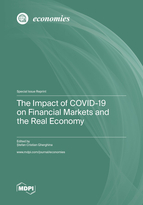The Impact of COVID-19 on Financial Markets and the Real Economy
A special issue of Economies (ISSN 2227-7099).
Deadline for manuscript submissions: closed (20 August 2022) | Viewed by 135173
Special Issue Editor
Interests: corporate finance; corporate governance; quantitative finance; sustainable development
Special Issues, Collections and Topics in MDPI journals
Special Issue Information
Dear Colleagues,
Ten years after the global financial crisis of 2008–2009, the COVID-19 outbreak in March 2020 caught the world by surprise—an unexpected and hard-to-predict issue which has been regarded as a “Black Swan” event. Even though the roots of the coronavirus are not in the financial system, its influence propagated throughout the economy via quarantine measures, remote working, or physical distancing which significantly reduced both supply and demand worldwide. The large-scale dispersion of COVID-19 intensified market risk aversion, with businesses becoming indebted, unemployment rates soaring throughout major economies, and the travel industry and hospitality sector coming to a standstill. Moreover, the panic associated with the effect of COVID-19 on the global economy harmed investor sentiment and lowered stock prices in leading markets. The Dow Jones Industrial Average experienced its worst day since the “Black Monday” market crash in 1987 and its third-worst day ever. Additionally, Treasury markets broke down, with an evident shortage of claims. That is not all: since its emergence, the pandemic has also impacted the overall petroleum trade, combining oversupply with a strong decrease in demand. For the first time in history, an oil futures contract went into negative values in April 2020. Overall, the health-induced crisis disrupted a bull market that had prevailed for more than a decade and established the 2020 bear market and recession.
This Special Issue will cover a wide range of topics, including but not limited to:
- Exploring the impact of COVID-19 on stock price crash risk;
- Investigating volatility spillovers between stock and energy markets during the COVID-19 pandemic crisis;
- Analyzing the connectedness of stock markets with gold and oil throughout the pandemic period;
- Assessing the impact of COVID-19 on stock market efficiency;
- Inspecting safe haven properties of cryptocurrencies during the COVID-19 pandemic;
- Estimating volatility in international sovereign bond markets in the course of the COVID-19 pandemic;
- Examining the impact of the COVID-19 pandemic on employment;
- Evaluating corporate insolvency following the COVID-19 outbreak.
Dr. Ştefan Cristian Gherghina
Guest Editor
Manuscript Submission Information
Manuscripts should be submitted online at www.mdpi.com by registering and logging in to this website. Once you are registered, click here to go to the submission form. Manuscripts can be submitted until the deadline. All submissions that pass pre-check are peer-reviewed. Accepted papers will be published continuously in the journal (as soon as accepted) and will be listed together on the special issue website. Research articles, review articles as well as short communications are invited. For planned papers, a title and short abstract (about 100 words) can be sent to the Editorial Office for announcement on this website.
Submitted manuscripts should not have been published previously, nor be under consideration for publication elsewhere (except conference proceedings papers). All manuscripts are thoroughly refereed through a single-blind peer-review process. A guide for authors and other relevant information for submission of manuscripts is available on the Instructions for Authors page. Economies is an international peer-reviewed open access monthly journal published by MDPI.
Please visit the Instructions for Authors page before submitting a manuscript. The Article Processing Charge (APC) for publication in this open access journal is 1800 CHF (Swiss Francs). Submitted papers should be well formatted and use good English. Authors may use MDPI's English editing service prior to publication or during author revisions.
Keywords
- COVID-19
- Impact of coronavirus on the stock market
- Pandemic and investor sentiment
- Effect of COVID-19 on cryptocurrencies
- Impact of the pandemic on oil prices
- COVID-19 pandemic and economic policy uncertainty
- Influence of the pandemic on corporate bankruptcy
- Effect of COVID-19 on employment






